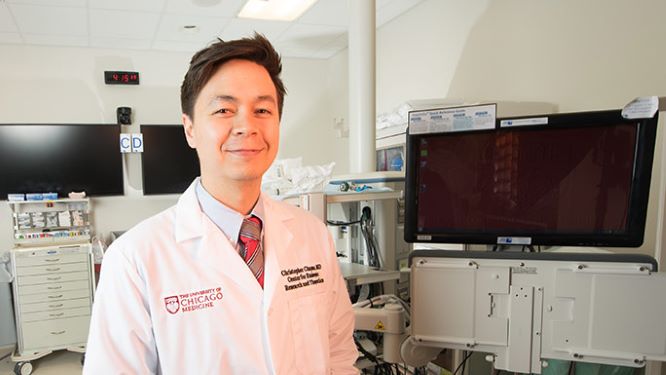Bariatric endoscopy, a promising new area for GI research and treatment, benefits patients seeking significant weight loss who do not meet the criteria for more permanent bariatric surgery. This new option can dramatically change the lives of patients struggling to achieve and maintain significant weight loss.
In 2016, Christopher Chapman, MD, Assistant Professor of Medicine at the University of Chicago Digestive Diseases Center, helped establish the new multidisciplinary Bariatric and Metabolic Endoscopy program at the University of Chicago Medicine. There, he and his colleagues introduced bariatric endoscopy as a first line treatment for obesity.
“Bariatric endoscopy addresses an important gap in treatment options for obesity,” explains Chapman. “Bariatric surgery is only approved for patients with a BMI over 40, or over 35 with comorbidities. But people with a BMI of 25 or 30 are considered overweight or obese, and sometimes have significant associated health concerns. If someone needs to lose forty to sixty excess pounds to improve their health, a bariatric endoscopy procedure can be a good option for them, and not permanent, like bariatric surgery.”
Bariatric endoscopy includes three specific procedures: intragastric balloons, endoscopic sleeve gastroplasty (ESG), and aspiration therapy.
Intragastric balloon is a reversible endoscopic procedure wherein a physician places a fluid- or gas-filled balloon into a patient’s stomach for approximately six months, after which it is removed. The balloon causes patients to feel full more quickly when eating, and to eat less. Combined with diet and lifestyle changes that continue following the removal of the balloon, patients can achieve significant long-term weight loss with this therapy.
In endoscopic sleeve gastroplasty (ESG), a physician uses an endoscopic suturing device on the inside of the stomach to reduce the size and volume of the stomach by sixty to seventy percent. This size restriction helps patients feel full faster and eat less. Patients who undergo ESG tend to lose 15-20% of their total body weight, and can maintain the loss for years.
“We are the only medical center in Chicago doing this,” adds Chapman, “And we have had great success. I am hopeful we can continue to expand in the future.”
In aspiration therapy, a large gastrostomy tube is placed through a patient’s skin into the stomach. Approximately thirty minutes after eating, the patient uses the tube to flush their stomach with water, and empty the contents, thereby absorbing fewer calories and nutrients. Patients who undergo aspiration therapy achieve significant weight loss. It’s the only endoscopic procedure that is FDA approved for a patient with a BMI up to 55, and it leads to significant weight loss.
Chapman and his colleagues continue to pursue needed research on bariatric endoscopy. While some of these procedures are considered investigational, and therefore elective procedures, they have strong safety records. But more research is still needed to understand the mechanisms of weight loss. With Eugene B. Chang, MD, Professor of Medicine at the University of Chicago Digestive Diseases Center and others, Chapman explores the role of the microbiome in these procedures, sampling patients’ microbiota prior to the intervention and then again six months to a year later. Chapman and colleagues are also conducting a large, multisite randomized study on the efficacy and durability of the ESG procedure over time.
Chapman is optimistic about his research. He explains, “I fully predict that this study will show that ESG is an effective option for patients interested in significant weight loss. For some patients, this sort weight loss can mean improved mobility or living with less pain. It can also open up treatment options for other conditions, or lead to better outcomes for other needed medical treatment over time.”

